Battling Wildfires From The Sky... Water Vs. Retardant
Top Stories
15 Aug 2018 7:22 PM
The 2018 wildfire season, has unfortunately, been an extremely active one. More fires seem to ignite each week. We've all seen the scenes of firefighters battling the blazes on the ground, while helicopters and planes attack the flames from the air.
But when do aerial crews drop water, and when do they drop fire retardant? Why? What's the difference? And what are the ingredients that comprise fire retardant? Is is safe for the environment?
Water is used when attempting to extinguish flames directly. It's dropped right onto the fire, usually by helicopters. The helicopters have special buckets attached by a cable. The buckets have release valves which are controlled by the helicopter crews. The buckets can be filled at nearby water sources, such as lakes, rivers, or ponds. Even swimming pools have been used! Helicopter crews can work in close proximity to the fire, without having to return to a distant base to refill drop buckets. All they need is a nearby source of water. Many water drops can be made in a short amount of time.
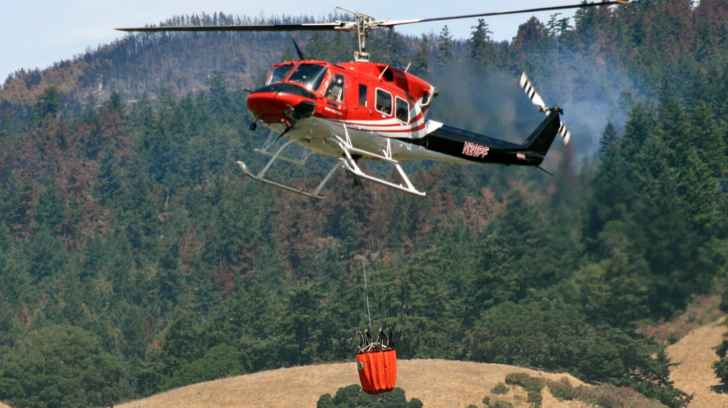
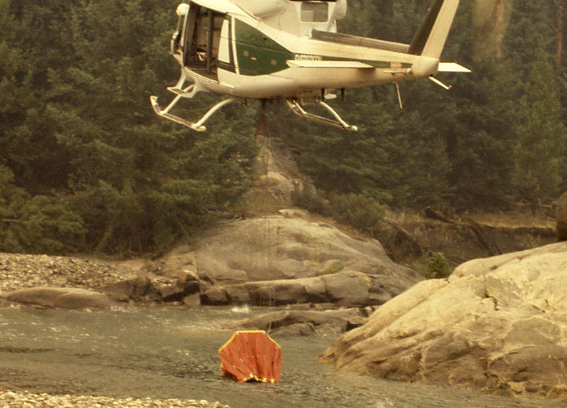
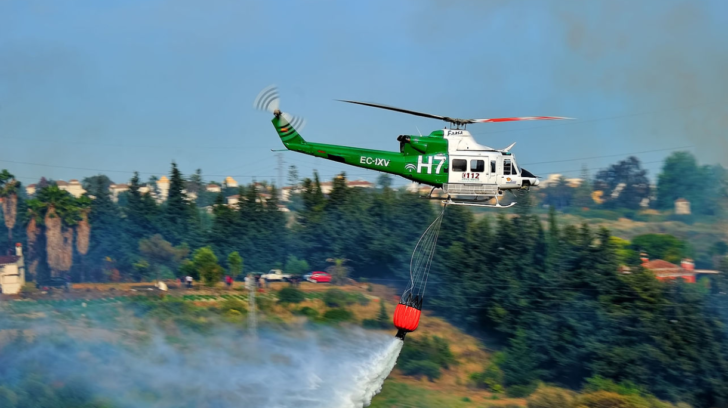 Conversely, airplane tankers with fire retardant must work out of a permanent base. They must land to pick up another load of retardant. Sometimes the base is a long distance from the fire. Only one retardant drop can be made per trip. So it's not as efficient as a water drop. The fire retardant itself is also more costly than using water from a lake. And the airplane fuel costs are higher per drop due to the back and forth nature of the process.
Fire retardant is also used differently. It is not dropped on to the fire directly, but rather ahead of the advancing flames. It is used to impede the fire from spreading past the point where it is dropped. It can also be used to box in a fire and contain it, or alter the path of a fire. But what is fire retardant?
Fire retardant is known as slurry. It's basically a mixture of mostly water and fertilizer. It was designed to protect trees, homes, and another structures from going up in flames. The mixture coats trees and vegetation, providing insulation against the approaching fire. The fertilizer helps damaged areas regrow after the fire is over. Unlike water, the fertilizer doesn't evaporate. So it provides a benefit for an extended period of time. The slurry is also dyed bright red to make it more visible. It helps pilots drop retardant more effectively.
Conversely, airplane tankers with fire retardant must work out of a permanent base. They must land to pick up another load of retardant. Sometimes the base is a long distance from the fire. Only one retardant drop can be made per trip. So it's not as efficient as a water drop. The fire retardant itself is also more costly than using water from a lake. And the airplane fuel costs are higher per drop due to the back and forth nature of the process.
Fire retardant is also used differently. It is not dropped on to the fire directly, but rather ahead of the advancing flames. It is used to impede the fire from spreading past the point where it is dropped. It can also be used to box in a fire and contain it, or alter the path of a fire. But what is fire retardant?
Fire retardant is known as slurry. It's basically a mixture of mostly water and fertilizer. It was designed to protect trees, homes, and another structures from going up in flames. The mixture coats trees and vegetation, providing insulation against the approaching fire. The fertilizer helps damaged areas regrow after the fire is over. Unlike water, the fertilizer doesn't evaporate. So it provides a benefit for an extended period of time. The slurry is also dyed bright red to make it more visible. It helps pilots drop retardant more effectively.
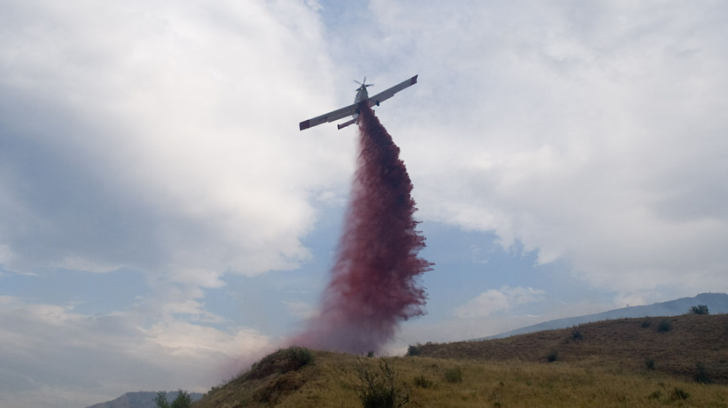
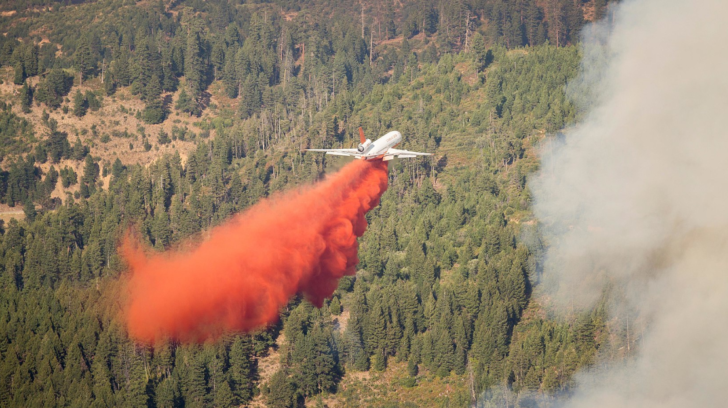 And although the bright red retardant looks like it might be harmful to the environment, it's not. However, planes avoid dropping retardant near lakes, streams and other waterways. In highly sensitive areas, tankers drop plain water instead. And just like with any type of fertilizer, The Forest Service advises against allowing pets to swallow any material coated with the slurry mix.
Battling wildfires is a tough and dangerous job. But water and retardant drops go a long way to help win the war against these raging infernos.
For WeatherNation: Meteorologist Matt Monroe
And although the bright red retardant looks like it might be harmful to the environment, it's not. However, planes avoid dropping retardant near lakes, streams and other waterways. In highly sensitive areas, tankers drop plain water instead. And just like with any type of fertilizer, The Forest Service advises against allowing pets to swallow any material coated with the slurry mix.
Battling wildfires is a tough and dangerous job. But water and retardant drops go a long way to help win the war against these raging infernos.
For WeatherNation: Meteorologist Matt Monroe


 Conversely, airplane tankers with fire retardant must work out of a permanent base. They must land to pick up another load of retardant. Sometimes the base is a long distance from the fire. Only one retardant drop can be made per trip. So it's not as efficient as a water drop. The fire retardant itself is also more costly than using water from a lake. And the airplane fuel costs are higher per drop due to the back and forth nature of the process.
Fire retardant is also used differently. It is not dropped on to the fire directly, but rather ahead of the advancing flames. It is used to impede the fire from spreading past the point where it is dropped. It can also be used to box in a fire and contain it, or alter the path of a fire. But what is fire retardant?
Fire retardant is known as slurry. It's basically a mixture of mostly water and fertilizer. It was designed to protect trees, homes, and another structures from going up in flames. The mixture coats trees and vegetation, providing insulation against the approaching fire. The fertilizer helps damaged areas regrow after the fire is over. Unlike water, the fertilizer doesn't evaporate. So it provides a benefit for an extended period of time. The slurry is also dyed bright red to make it more visible. It helps pilots drop retardant more effectively.
Conversely, airplane tankers with fire retardant must work out of a permanent base. They must land to pick up another load of retardant. Sometimes the base is a long distance from the fire. Only one retardant drop can be made per trip. So it's not as efficient as a water drop. The fire retardant itself is also more costly than using water from a lake. And the airplane fuel costs are higher per drop due to the back and forth nature of the process.
Fire retardant is also used differently. It is not dropped on to the fire directly, but rather ahead of the advancing flames. It is used to impede the fire from spreading past the point where it is dropped. It can also be used to box in a fire and contain it, or alter the path of a fire. But what is fire retardant?
Fire retardant is known as slurry. It's basically a mixture of mostly water and fertilizer. It was designed to protect trees, homes, and another structures from going up in flames. The mixture coats trees and vegetation, providing insulation against the approaching fire. The fertilizer helps damaged areas regrow after the fire is over. Unlike water, the fertilizer doesn't evaporate. So it provides a benefit for an extended period of time. The slurry is also dyed bright red to make it more visible. It helps pilots drop retardant more effectively.

 And although the bright red retardant looks like it might be harmful to the environment, it's not. However, planes avoid dropping retardant near lakes, streams and other waterways. In highly sensitive areas, tankers drop plain water instead. And just like with any type of fertilizer, The Forest Service advises against allowing pets to swallow any material coated with the slurry mix.
Battling wildfires is a tough and dangerous job. But water and retardant drops go a long way to help win the war against these raging infernos.
For WeatherNation: Meteorologist Matt Monroe
And although the bright red retardant looks like it might be harmful to the environment, it's not. However, planes avoid dropping retardant near lakes, streams and other waterways. In highly sensitive areas, tankers drop plain water instead. And just like with any type of fertilizer, The Forest Service advises against allowing pets to swallow any material coated with the slurry mix.
Battling wildfires is a tough and dangerous job. But water and retardant drops go a long way to help win the war against these raging infernos.
For WeatherNation: Meteorologist Matt MonroeAll Weather News
More